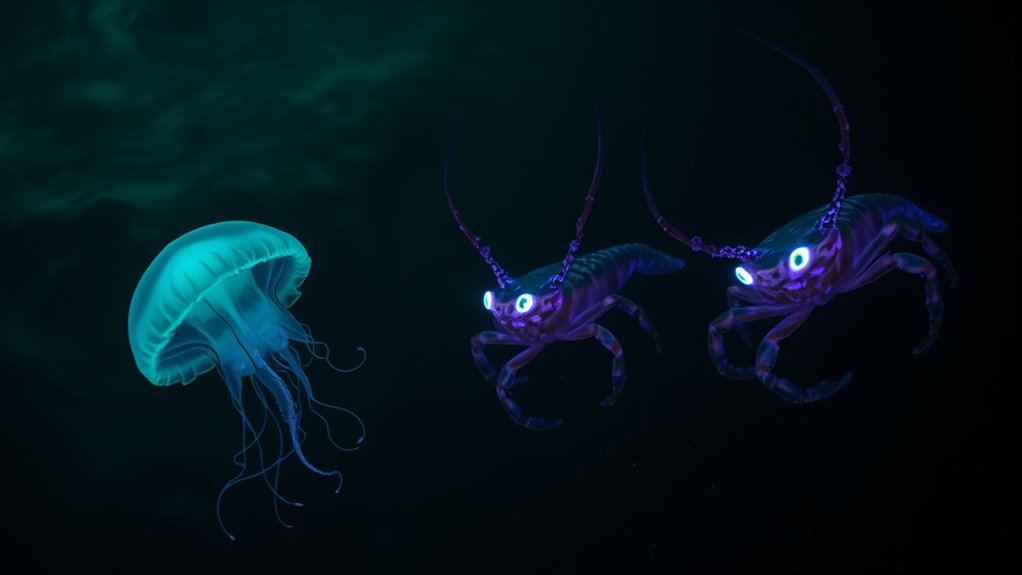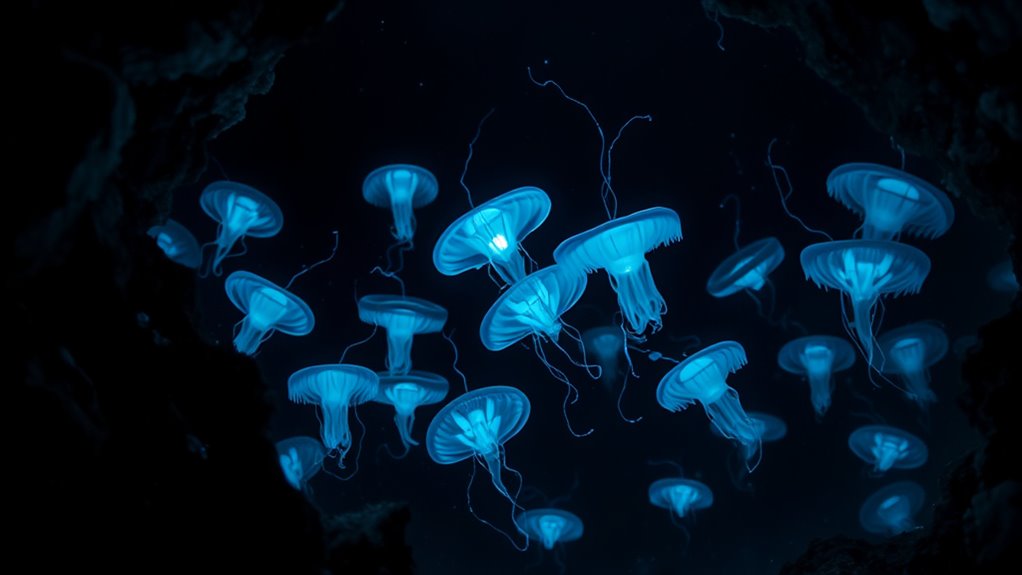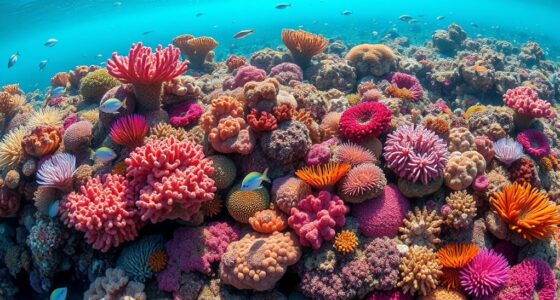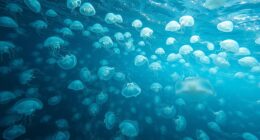Deep-sea brine pool creatures live in some of Earth’s most extreme environments, where salinity, pressure, and toxins are incredibly high. They’ve evolved remarkable adaptations like protective outer layers, specialized enzymes, and unique metabolic pathways to survive. Many are completely unknown to science, showcasing incredible biodiversity in harsh conditions. Their biochemically distinct features could inspire future biotechnologies. If you’re curious about how these extraordinary life forms push boundaries, discover more about their secret lives below the surface.
Key Takeaways
- Deep-sea brine pool creatures have unique adaptations allowing survival in highly saline, toxic, and high-pressure environments.
- Many species remain undiscovered, showcasing extreme biodiversity and specialized metabolic pathways.
- They often utilize bioluminescence for communication, predation, or navigation in the dark depths.
- Symbiotic bacteria help detoxify chemicals and provide nutrients, forming complex ecological relationships.
- Their biochemical features offer potential for biotechnological and industrial applications due to enzyme stability under extreme conditions.

Deep-sea brine pools are among Earth’s most extreme and mysterious environments, harboring unique creatures that thrive where few others can survive. These pools are pockets of highly saline water, often many times saltier than the surrounding ocean, creating a hostile environment that tests the limits of life. If you explore these depths, you’ll discover that the creatures inhabiting brine pools have developed extraordinary adaptations to cope with the intense conditions. Their extreme adaptations enable them to endure high salinity, toxic chemicals, and crushing pressures, making their survival a proof to life’s resilience. This specialized group contributes considerably to abyssal biodiversity, revealing a hidden world teeming with biological diversity unlike any other.
You might find that these organisms have evolved ways to withstand the chemical toxicity and extreme temperature fluctuations within brine pools. Some creatures have developed protective outer layers or specialized enzymes that function efficiently despite the harsh chemical environment. Others have adapted unique metabolic pathways that allow them to extract energy from chemicals toxic to most life forms. These extreme adaptations are essential because they enable survival in conditions that would annihilate most terrestrial or shallow-water species. As a result, the biodiversity in these abyssal zones is remarkably diverse, despite the extreme circumstances, with species that are often completely unknown to science.
Your curiosity might lead you to learn that many of these creatures are biochemically distinct, with unique adaptations that could even have pharmaceutical or biotechnological applications. For example, enzymes from brine pool organisms can function under extreme conditions, offering potential for industrial processes requiring high salinity or temperature stability. This biodiversity not only fascinates scientists but also holds promise for future discoveries that could benefit humanity.
In these depths, you’ll observe that some creatures use bioluminescence for communication or predation, contrasting sharply with the dark, pressure-filled environment they inhabit. Others have symbiotic relationships with bacteria that detoxify the environment or provide nutrients, illustrating complex ecological interactions. These relationships further underscore the rich abyssal biodiversity that exists beneath the ocean’s surface, hidden from view yet essential to understanding life’s adaptability. Exploring these environments reveals a world where life pushes its boundaries, thriving through extreme adaptations that allow them to flourish in the abyssal depths of brine pools. It’s a reminder that even in the most inhospitable places, life persists and evolves in astonishing ways.
Frequently Asked Questions
How Do Deep-Sea Brine Pool Creatures Communicate?
You might wonder how deep-sea brine pool creatures communicate. They often use bioluminescent signaling, flashing lights to send messages in the dark environment. Additionally, acoustic communication plays a key role, with creatures producing sounds that travel through the water. These methods help them coordinate, find mates, or warn others, despite the extreme conditions. Both bioluminescence and sound are essential for their survival and interaction in the deep ocean.
What Is Their Lifespan in Extreme Environments?
In extreme environments, you might wonder about their lifespan. These creatures often rely on bioluminescent signaling for communication and reproduction, which helps them survive harsh conditions. Their lifespan varies, but many are adapted to short, intense lives, focusing on rapid reproduction through unique strategies. Their ability to efficiently reproduce and communicate in such settings allows them to maximize survival despite the extreme environment.
Do They Have Any Predators in Brine Pools?
Ever wonder if deep-sea brine pool creatures throw predator parties? In this quirky brine pool ecology, you’d think they’re invincible, but some predators have surprisingly savvy adaptations. They hide in the extreme environment, blending in or sneaking up like underwater ninja warriors. So, yes, even in these alien-like pools, predators exist, proving that survival’s a game of predator adaptations, no matter how bizarre the setting.
Can These Creatures Survive Outside Their Environment?
You might wonder if these creatures can survive outside their environment. Their adaptation strategies and survival mechanisms are highly specialized for the extreme conditions of brine pools. If you expose them to surface conditions, they likely won’t survive because they lack the necessary adaptations, such as pressure tolerance and chemical resistance. Their bodies are finely tuned for their specific habitat, making survival outside it nearly impossible.
How Do They Find Food in Such Dark Depths?
You might wonder how these creatures find food in such darkness. They rely on bioluminescent signals to spot prey and communicate. Additionally, they use chemical detection, sensing faint scent trails in the water. These adaptations help them navigate the pitch-black environment, locate food, and survive in the deep sea’s extreme conditions. Their ability to see and sense their surroundings is crucial for their survival in this mysterious, dark world.
Conclusion
As you’ve seen, deep-sea brine pool creatures thrive in extreme environments, revealing nature’s incredible resilience. Their unique adaptations challenge what you think is possible in life’s limits. Isn’t it amazing how these hidden beings survive where most cannot? As you explore more about these mysterious creatures, remember there’s still so much to discover beneath the ocean’s surface. Who knows what other secrets the deep sea is hiding, waiting for you to uncover?









